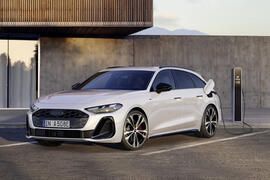 Plug-in powertrain pairs 2.0-litre turbo petrol engine with electric motor for 295bhp combined output
Plug-in powertrain pairs 2.0-litre turbo petrol engine with electric motor for 295bhp combined output
The Audi A5 will gain a plug-in hybrid variant in June, one of ten new PHEVs to be launched by the German brand across its line-up in 2025.
The new A5 arrived last November initially with petrol and diesel power, replacing the A4 in the now-dropped naming strategy that classed odd numbered cars as combustion powered and even numbered as electric cars.
The PHEV powertrain is centered around the 2.0-litre variant of Volkswagen Group’s ubiquitous EA888 turbo petrol four, which combines with a gearbox-housed 140bhp electric motor to deliver 295bhp. It is mated to a seven-speed ‘box and is exclusively sold in the UK in four-wheel drive Quattro guise.
A new 20.7kWh (usable) battery offers an electric-only range of 67 miles. It can be charged via a maximum AC current of 11kW. It can also be recharged via regenerative braking, with levels selected via paddles behind the steering wheel.
As with the other variants, it is offered in Avant and Saloon bodystyles. Prices start at £48,950 for the Saloon in Technik trim and max out at £60,520 for the Avant in Edition 1 trim. Deliveries pencilled for the middle of June.
The A5 will be joined by the A3, A6, Q5 next-generation Q3 in receiving PHEV setup this year.
The new Q7 and the larger Q9 - as it is currently known - will also gain PHEV power when they're launched in the coming years. This is part of a renewed push from Audi in extending the lifespan of its ICE range beyond 2032 given the differing speeds of EV adoption worldwide.
Speaking to Autocar last week, CEO Gernot Döllner said the transition to EV powertrains is "going to be longer than we had originally planned for", adding: “For all global regions, we are going to take a look at the life of combustion engines. 2032 was the date we had communicated, but we have to reassess those dates and deadlines."
As such, Audi has undertaken a substantial investment in new-generation hybrid technology in a bid to extend combustion powertrains for as long as possible. "On balance, an extension of combustion engines will have a positive impact on our business model," Döllner concluded